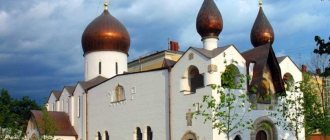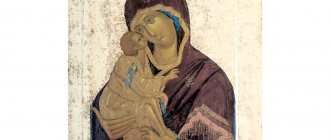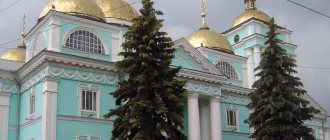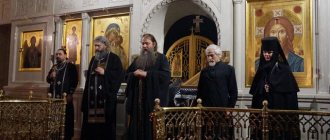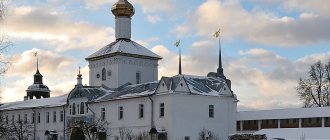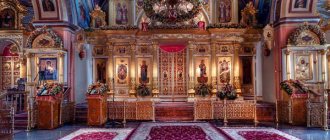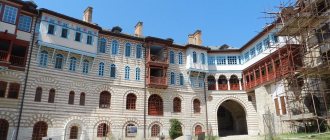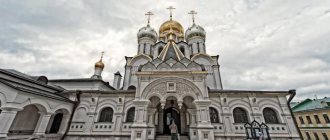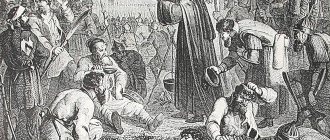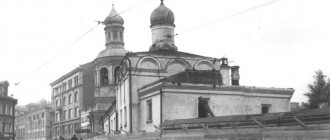The cover of love and care for thousands of disadvantaged, sick and needy people who in our time find refuge from everyday misfortunes is located in Moscow on the territory of the Marfo-Mariinsky Monastery.
| Marfo-Mariinskaya Convent | |
| A country | Russia |
| City | Moscow |
| Year of foundation | 1909 |
| Website | https://www.mmom.ru/ |
| Abbot | Abbess Elisaveta (Pozdnyakova) |
The Marfo-Mariinskaya Convent is a unique convent in the nature of its activities with a centuries-old history of a blessed time of work under the leadership of the founder, which survived the closure and restoration of a wonderful monastery, which today delights residents, parishioners and pilgrims.
A heart filled with love for the suffering led the princess to the path of merciful action
The history of the creation of the monastery began at the beginning of the 20th century. In Moscow there were a large number of charitable foundations and committees, the founder of which was the most famous Russian philanthropist Elizaveta Fedorovna.
In 1905, the benefactor’s husband, Grand Duke Sergei Alexandrovich, died. Having become a widow, the princess devoted her entire life to serving the Lord through helping her neighbors. Elizaveta Fedorovna sold her jewelry and estates, and with the proceeds she wanted to build a place where she could combine prayerful service to God and helping those in need.
Princess Elizaveta Feodorovna and Prince Sergei Alexandrovich
The princess decided to build a monastery and name it in honor of the two evangelical sisters of the righteous Lazarus of the Four Days - Martha, who loved to do good to the Lord in work, and Mary, who acquired prayer with all her heart.
In 1909, Grand Duchess Elizaveta Feodorovna received the blessing of the Holy Synod and bought an estate located on Bolshaya Ordynka. Over time, a hospital, an outpatient clinic with a pharmacy, an abbess’s house, a priest’s apartment, classrooms for education and a prosphora were established on the territory.
17 sisters
was in the first set of the monastery
A hotel for women was also built. A rose garden was laid out near the shelter building, and the winter garden was part of a temple, specially arranged for hospital patients. Bishop Trifon of Dmitrov (Turkestan) consecrated the hospital church in the name of the pious sisters Martha and Mary in the fall of 1909.
The official opening of the Marfo-Mariinsky Convent took place on February 10, 1909.
Exactly one year later, Elizaveta Fedorovna was elevated to the rank of abbess, and 17 sisters of the monastery, together with the founder, were ordained sisters of the cross.
Princess Elizaveta Feodorovna in the rank of abbess
The final stage in the arrangement of the monastery was the completion of construction in 1912 of the second church in honor of the Intercession of the Blessed Virgin Mary. The Church of the Intercession was built under the leadership of the architect Alexei Shchusev.
Below, at the request of the abbess of the monastery, a tomb was built for her. The belfry consisted of specially selected 12 bells, which sounded like the famous “Rostov ringing”.
February 10, 1909
official opening of the Marfo-Mariinsky monastery
Founding history
The history of the Marfo-Mariinsky Convent dates back to 1907, when Grand Duchess Elizaveta Feodorovna acquired a vast estate on Bolshaya Ordynka, deciding to devote her life to serving the Almighty and helping the suffering.
After the death of her husband, the princess sells all her property and uses the proceeds to equip outbuildings for the needs of the monastery. It took about two years to found the monastery. The two-story house with access to the main street was equipped as a hospital with a dressing room, a hospital and a room for operations. Here they allocated a room for a chapel, consecrated in the name of the righteous Martha and Mary. The house of the founder of the monastery was adjacent to the medical department, and on the other side there was an outpatient clinic and a pharmacy, above which there were rooms for nuns and sisters of mercy.
The house, located in the courtyard, was equipped as a Sunday school, where girls and women studied. The entire lower floor was given over to classrooms, and the protodeacon was placed on the upper floor. Priest Mitrofan Srebryansky remained the permanent spiritual mentor of the monastery until he was arrested in 1924. In the year two thousand, Father Mitrofan was canonized as a holy new martyr.
The final opening of the Marfo-Mariinsky monastery took place in the winter of 1909. At this time, six sisters were already living on its territory, by the end of the year there were already thirty of them, and the flow of those wishing did not dry up. Princess Elizaveta Feodorovna bought a neighboring plot of land, where a three-story building was erected.
In 1908, the foundation stone was laid for the cathedral church, the creation of which was worked on by such masters as M. Nesterov with his student P. Korin, A. Shchusev and the famous master of sculpture S. Konenkov. Construction work lasted four years, after which the temple was consecrated by Vladyka of Moscow Vladimir in honor of the Intercession of the Most Holy Theotokos.
The temple in the name of the Most Holy Theotokos is the most valuable cultural heritage, but its services, which were performed by the priest of the monastery, and sometimes by church hierarchs, Sunday conversations in the refectory and spiritual sermons, attracted the townspeople even more. Among other things, meetings of scientific societies, various events and religious readings were held in the refectory.
The relics of Saint Elizabeth, Alexy of Moscow, mother of John the Baptist, and also John Climacus were placed in the cathedral altars. Another church is located under the Intercession Church, consecrated in the name of the Heavenly Powers and All Saints. A staircase, painted by Pavel Korin, leads to the lower shrine. The decoration of the lower church was completely completed only in 1914. Three years later the temple was consecrated.
The main direction in the life of the monastery was medical assistance. The best doctors in Moscow were received within the walls of the monastery. In addition, they taught the sisters medical and nursing skills, and the abbess very skillfully assisted during dressings and operations of varying complexity.
The monastery's hospital had a reputation as a qualified medical institution in Moscow. The most seriously ill, hopeless and seriously wounded were sent here. Elizaveta Fedorovna equipped an infirmary on Bolshaya Ordynka for participants in the Russian-Japanese War, long before the official opening of the monastery.
The exceptional authority of the Marfo-Mariinsky monastery was so high that even the turbulent events of the revolution did not affect the life and way of life of the monastery. At first, the new government even supplied drugs and food. But time passed, laws changed. First, questionnaires were sent to the monastery, later several sisters were arrested, and the orphans were sent to orphanages.
In the spring of 1918, a detachment of riflemen came to the monastery for the abbess. She was given 30 minutes to collect her personal belongings. Princess Elizaveta Fedorovna said goodbye to everyone. The sisters were shocked by what was happening; they ran after the truck for a long time, wailing. At that time, there were already more than 100 people of different ages in the monastery.
They loved and respected each other, raised by the princess, they remained devoted to the Orthodox faith even after the closure of the Marfo-Mariinsky monastery. In July of the same year, Elizaveta Feodorovna and her nun Varvara, along with the rest of the members of the royal house, were thrown into a mine near Alapaevsk.
The Marfo-Mariinskaya Convent existed for another eight years, during which repressions and executions of the sisters continued. In 1928, worship was finally stopped in the Intercession Cathedral; a cinema was opened within its walls, and later a house of health education. A bust of Stalin was installed in the cathedral altar. After World War II, workshops for the restoration of works of art were located in the temple, and a physical therapy room was equipped in the hospital church of Saints Martha and Mary.
The hardworking sisters of the monastery simultaneously performed three types of service
Orthodox healthy women aged 21 to 40 were accepted into the sisterhood of the monastery. According to a specially thought-out charter, the sisters who inhabited the monastery took vows of chastity, non-covetousness and obedience for the duration of their service.
The nuns could leave the monastery after the expiration of time and were released from the promises they had made, which made it possible for women to get married if they wished.
Before starting service, all sisters were trained in spiritual laws and the basics of medical care.
The monastery conducted three types of services simultaneously:
- The guardianship service consisted of visiting those in need outside the monastery. Elizaveta Fedorovna and her sisters constantly helped local residents. The abbess often took young children from disadvantaged families to be raised in her orphanage.
- The sisters of the educational ministry raised orphan girls in the orphanage. They were professionally trained to become maids and nannies. The abbess organized a Sunday school, in which the sisters also worked.
- Active ministry took place in a hospital, outpatient clinic and pharmacy. The free hospital consisted of 22 beds for patients and one operating room. The medical complex of the monastery was recognized as the best in Moscow.
There was also a general library, which contained about two thousand books.
2000
books numbered in the monastery library
During the First World War, a hospital was located in the monastery. Two-month training courses for nurses were opened. Elizaveta Feodorovna became the founder of the All-Russian Charity Headquarters, for which warehouses were set up for donations from all concerned, who were then sent to the front.
In 1914, the princess wrote her own book, “Under a Gracious Sky,” and donated all the proceeds from sales to the needs of children of military personnel
Since the death of the abbess, the monastery has been devastated
Elizabeth Feodorovna's charitable activities ceased on May 7, 1918, when Mother, along with her cell attendant Varvara Yakovleva, as well as the entire imperial family, were arrested. On the night of July 18, 1918, all members of the royal family were thrown alive into a mine in the city of Alapaevsk.
1926
until this year the Marfo-Mariinsky monastery existed
In 1919, all church property was transferred to the Marfo-Mariinsky labor community, and in 1922, some of the church property was confiscated. The monastery existed in its active state only until 1926, then during times of revolutions and war they tried to place a clinic, laboratory, cinema and workshops in it.
The resumption of activity preserved the previous way of life of the monastery
In 1992, by government decree, the Marfo-Mariinsky Monastery was returned to the Moscow Patriarchate. But the Intercession Cathedral was returned only in 2006.
By 2008, the monastery had undergone repair and restoration work to recreate the original appearance of every corner of the monastery. In the chambers of the founder, the previous interior was updated and an exhibition was placed with fragments of the saint’s life, as well as the history of the monastery.
Monuments to Elisaveta Feodorovna and the cross of the Alapaevsk martyrs were erected on the territory. Also, through the efforts of the nuns, the rose garden was restored.
In 2014, the Holy Synod decided to transform the Martha and Mary Convent of Mercy into the stauropegial Martha and Mary Monastery, which implies subordination of activities to the patriarch, while preserving the way of life of the nuns established by the Holy Martyr Elizabeth.
The Convent of Mercy now has 30 nuns with Abbess Elisaveta (Pozdnyakova).
Abbess of the Marfo-Mariinsky Monastery together with clergy, sisters and pupils of the monastery
Today the following organizations operate at the monastery:
- medical Center;
- Elizabeth Orphanage;
- Family placement center for orphans;
- rehabilitation center for children with cerebral palsy;
- holiday cottage for disabled children;
- children's mobile palliative service with a register attached to it;
- courses for pregnant women;
- School of Foster Parents;
- Mercy school.
There are many volunteers constantly providing services at the monastery. The total number of workers is 250 people.
Current state
The revival of the monastery began in 1992, when the territory was transferred to the Moscow Patriarchate. Eight years later, the monastery acquired the status of the Patriarchal Metochion. In 2006, headed by the Bishop of Moscow and All Rus' Alexy, the Board of Trustees drew up a plan for the revival of the Marfo-Mariinsky monastery. In the winter of the same year, by decree of the bishop, Abbess Natalya was appointed to the position of abbess. Today, the abbess of the convent is Abbess Elizabeth.
There are two types of sisters in the monastery: some took monastic vows, and the second are sisters of mercy. As a rule, these are lay women who do not bind themselves to the vow of monasticism, but along with “working on the soul,” they also perform other duties and do not drop out of social life.
Today, like a hundred years ago, the monastery operates according to the Charter, which was introduced by Mother Elizabeth. The sisters study medicine at the St. Demetrius School, work in hospitals and clinics, and take care of the affairs of the monastery. Just like under the princess, the monastery has a shelter for orphans, a guardianship service, a free canteen, an educational center and a gymnasium.
In addition, a center for children with cerebral palsy was opened at the monastery. A twenty-day course was developed especially for such children. Comprehensive rehabilitation includes sessions with a neurologist, osteopath, orthopedist, speech pathologist, physiotherapist and psychologist. The goal of the course is to completely rid the patient of convulsive syndromes and seizures.
You can get to the monastery by metro and buses
You can find the Marfo-Mariinskaya Convent of Mercy at the address: Moscow, Bolshaya Ordynka Street, building 34.
It is convenient to get there on foot from the Polyanka, Tretyakovskaya or Novokuznetskaya metro stations. Or by bus No. M5 (stop “Iversky Pereulok”), bus No. M6 and trolleybus No. 8 (stop “Metro “Polyanka””).
Official website of the Marfo-Mariinskaya Convent
The schedule of services and more detailed information about the monastery is presented on the official website of the monastery.
You can listen to the history of the Marfo-Mariinsky Monastery and see what the interior of the temple and territory looks like by following the link to the video.
By leaving a comment, you accept the user agreement
Official website of the Marfo-Mariinskaya Convent
mmom.ru
The complete reconstruction of the monastery was completed in 2008, affecting not only the internal and external decoration of the churches, but also the buildings of the sisters' dormitories, Sunday school, outbuildings and improvement facilities. The founder's chambers were restored and it was decided to open a museum in them. Visitors can still see here unique photographs taken during the life of Elizabeth Feodorovna, her personal belongings, drawings, and correspondence. The guide will tell you about the history of the founding of the monastery, its activities in pre-revolutionary times and today.
Sundays after the end of the Liturgy are reserved for visiting the museum. For visitors in groups on weekdays, excursions are available by appointment. For an individual visit, a sightseeing tour is provided at 11 and 15 hours, it is held daily. Phone numbers, email addresses and details for transferring donations can be found on the monastery website. There you can also find a lot of information about what kind of help the monastery provides, what specialists it needs, and what help you can provide.
There is no hotel at the complex, so non-residents cannot stay on the territory of the monastery. However, there is a cafe inside where visitors can have a snack.
